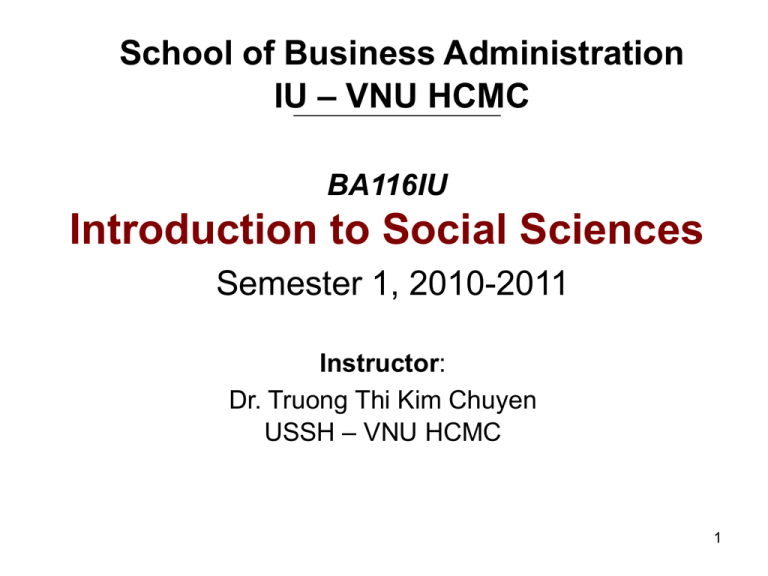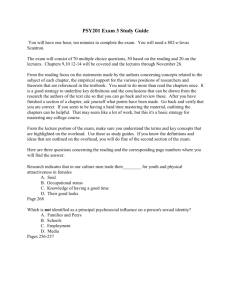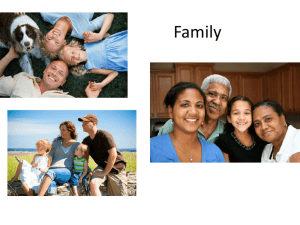Family - Introduction to Sociology and World Economic Geography
advertisement

School of Business Administration IU – VNU HCMC BA116IU Introduction to Social Sciences Semester 1, 2010-2011 Instructor: Dr. Truong Thi Kim Chuyen USSH – VNU HCMC 1 Chapter 12 The family and Intimate Relationships Chapter Outline • • • • • • Global View of the Family Studying the Family Marriage and Family Divorce Diverse Lifestyles SOCIAL POLICY AND THE FAMILY: Gay Marriage 2 McGraw-Hill 2006 The Family: A Global View • Composition: What Is the Family? – Family: set of people related by blood, marriage, or some other agreed-upon relationship, or adoption who share primary responsibility for reproduction and caring for members of society 3 The Family: A Global View • Composition: What Is the Family? – Nuclear Family: nucleus or core upon which larger family groups are built – Extended Family: family in which relatives live in same home as parents and their children Serial Monogamy: when a person has several – Monogamy: form of marriage inspouses whichin his or her woman lifetime, but only oneman spouseare at amarried time one and one only to each other 4 The Family: A Global View • Composition: What Is the Family? – Polygamy: when an individual has several husbands or wives simultaneously – Polygyny: marriage of a man to more than one woman at a time – Polyandry: marriage of a woman to more than one husband at the same time. 5 The Family: A Global View Figure 14-1. U.S. Households by Family Type, 1940—2003 Source: Fields 2004; see also McFalls, Jr. 2003:23 6 The Family: A Global View • Kinship Patterns: To Whom Are We Related? – Kinship: state of being related to others • Bilateral Descent: both sides of a person’s family are regarded as equally important • Patrilineal descent: only the father’s relatives are important • Matrilineal descent: only the mother’s relatives are significant 7 The Family: A Global View • Authority Patterns: Who Rules? – Patriarchy: males are expected to dominate in all family decision making – Matriarchy: women have greater authority than men – Egalitarian family: family in which spouses are regarded as equals 8 Social Institutions: Family and Religion • Social Institution – Organized patterns of beliefs and behavior centered on general basic needs • Functionalist View – Family serves six functions for society: 1. 2. 3. 4. 5. 6. Protection Socialization Reproduction Regulation of sexual behavior Affection and companionship Provision of social status 9 Studying the Family • Conflict View – Family reflects inequality in wealth and power found within society – In wide range of societies, husbands exercised power and authority within the family – View family as economic unit contributing to social injustice 10 Studying the Family • Interactionist View – Focuses on micro level of family and other intimate relationships – Interested in how individuals interact with each other whether they are cohabiting partners or longtime married couples 11 Studying the Family • Feminist View – Urged social scientists and social agencies to rethink notion that families in which no adult male is present are automatically a cause for concern – Feminists stress the need to investigate neglected topics in family studies 12 Studying the Family Table 14-1. Sociological Perspectives on the Family 13 Marriage and Family • Courtship and Mate Selection – Aspects of Mate Selection • Endogamy: Endogamy specifies the groups within which a spouse must be found and prohibits marriage with members of other groups. • Exogamy: Exogamy requires mate selection outside certain groups, usually one’s own family or certain kin. 14 Marriage and Family • Courtship and Mate Selection – Aspects of Mate Selection Incest Taboo: social norm common to virtually all societies prohibiting sexual relationships between certain culturally specified relationships • Homogamy: conscious or unconscious tendency to select mate with personal characteristics similar to one’s own – The Love Relationship • Coupling of love and marriage not universal 15 Marriage and Family • Variations in Family Life and Intimate Relationships – Social Class Differences • The upper class emphasizes lineage and maintenance of family position; lower class families likely to have one parent at home, and children typically assume adult responsibilities – Racial and Ethnic Differences • Subordinate status of racial and ethnic groups profoundly affects family life 16 Marriage and Family • Child-Rearing Patterns in Family Life – Parenthood and Grandparenthood • One of most important roles of parents is socialization of children • Recently, U.S. witnessed extension of parenthood with adult children living at home – “Boomerang generation” or “full-nest syndrome” 17 Marriage and Family • Child-Rearing Patterns in Family Life – Adoption • Process that “allows for the transfer of the legal rights, responsibilities, and privileges of parenthood” to a new legal parent or parents – Dual-Income Families • Among married people between the ages of 25 and 34, 92% of men and 75% of women in the labor force 18 Marriage and Family • Child-Rearing Patterns in Family Life – Single-Parent Families • In 2000, a single parent headed: – 21% of White families with children – 35% of Hispanic families with children – 55% of African American families with children – Stepfamilies • Rising rate of divorce and remarriage led to significant increase in stepfamily relationships • Stepfamilies are exceedingly complex 19 Marriage and Family Figure 14-2. Percentage of People Aged 20 to 24 Ever Married, Selected Countries Source: United Nations Population Division 2005 20 Divorce • Statistical Trends in Divorce – Divorce rates increased in late 1960s, started to level and decline since late 1980s – About 63% of all divorces in U.S. remarry 21 Divorce • Factors Associated with Divorce •Greater social acceptance of divorce •More liberal divorce laws •Fewer children •Greater family income •More opportunities for women • Impact of Divorce on Children – About a third of children benefit from divorce because it lessens exposure to conflict 22 Divorce Figure 14-3. Rise of Single-Parent Families in the United States, 1970-2000 Source: Bureau of the Census 1994:63; Fields 2001:7 23 Divorce Figure 14-4. Trends in Marriage and Divorce in the United States, 1920—2004 Source: Bureau of the Census 1995:64; National Vital Statistics Reports 2005 24 Diverse Lifestyles • Cohabitation • Remaining Single • Marriage without Children • Lesbian and Gay Relationships 25 Diverse Lifestyles Figure 14-5. Unmarried-Couple Households by State Source: T. Simmons and O’Connell 2003:4 26 Social Policy and The Family • Gay Marriage – The Issue • Idea of same-sex marriage strikes some in U.S. as attack on traditional marriage – The Setting • Vermont gave gay couples legal benefits of marriage through civil union • Massachusetts Supreme Courts rule state’s constitution gives gay couples right to marry 27 Social Policy and The Family • Gay Marriage – Sociological Insights • Functionalists: religious views toward marriage cannot be ignored • Conflict theorists: denial of right to marry reinforces second-class citizenship • Interactionists: focus on support or opposition of family, co-workers, and friends • As many as 50% of citizens favor civil union 28 Social Policy and The Family • Gay Marriage – Policy Initiatives • Netherlands, Belgium, and Canada recognize same-sex marriages • Many nations remains strongly opposed • In U.S. local jurisdictions have recognized domestic partnerships for benefits 29 Social Policy and The Family Figure 14-6. Discriminatory Marriage and Anti-Gay Discrimination Laws Source: Human Rights Campaign 2005 30 Key terms • Adoption In a legal sense, a process that allows for the transfer of the legal rights, responsibilities and privileges of parenthood to a new legal parent or parents. • Bilateral descent A kinship system in which both sides of a person’s family are regarded as equally important • Cohabitation The practice of living together as a male – female couple without marrying. • Domestic partnership Two unrelated adults who share a mutually caring relationship, reside together, and agree to be jointly responsible for their dependents, basic living expenses, and other common necessities. • Egalitarian family An authority pattern in which spouses are regarded as equals. • Endogamy The restriction of mate selection to people within the same group. 31 Key terms • Exogamy The requirement that people select a mate outside certain groups. • Extended family A family in which relatives-such as grandparents, aunts, or uncles – live in the same home as parents and their children. • Familism Pride in the extended family, expressed through the maintenance of close ties and strong obligations to kinfolk outside the immediate family. • Family A set of people related by blood, marriage or some other agreed-upon relationship, or adoption, who share the primary responsibility for reproduction and caring for members of society. • Incest taboo The prohibition of sexual relationships between certain culturally specified relatives. • Kinship The state of being related to others. • Machismo A sense of virility, personal worth, and pride in one’s maleness. 32 SUMMARY • The family, in its many varying forms, is present in all human cultures. This chapter examines the state of marriage, the family, and other intimate relationships in the United States and considers alternatives to the traditional nuclear family. Families vary from culture to culture and even within the same culture. The structure of the extended family can offer certain advantages over that of the nuclear family. Societies determine kinship by descent from both parents (bilateral descent), from the father only (patrilineal descent), or from the mother only (matrilineal descent). 33 Sociologists do not agree on whether the egalitarian family has replaced the patriarchal family as the social norm in the United States. William F. Ogburn outlined six basic functions of the family: reproduction, protection, socialization, regulation of sexual behavior, companionship, and the provision of social status. Conflict theorists argue that male dominance of the family contributes to societal injustice and denies women opportunities that are extended to men. Interactionists focus on how individuals interact in the family and in other intimate relationships. 34 Feminists stress the need to broaden research on the family. Like conflict theorists, they see the family's role in socializing children as the primary source of sexism. People select mates in a variety of ways. Some marriages are arranged; in other societies people choose their own mates. Some societies require mates to be chosen within a certain group (endogamy) or outside certain groups (exogamy). And consciously or unconsciously, many people look for a mate with similar personal characteristics (homogamy). In the United States, family life varies with social class, race, and ethnicity. 35 • Currently, in the majority of all married couples in the United States, both husband and wife work outside the home. • Single-parent families account for an increasing proportion of U.S. families. • Among the factors that contribute to the rising divorce rate in the United States are greater social acceptance of divorce and the liberalization of divorce laws in many states. 36 • More and more people are living together without marrying, a practice known as cohabitation. People are also staying single longer, and some married couples are deciding not to have children. • The gay marriage movement, which would confer equal rights on gay and lesbian couples and their dependents, is strongly opposed by conservative religious and political groups. 37





